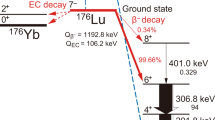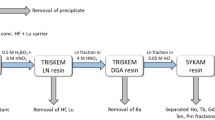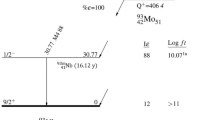Abstract
RECENTLY a powerful method for the determination of α-ray half-lives has been described1,2,3. The method consists essentially in counting the α-ray tracks produced in a photographic emulsion by the decaying nuclei. The nuclei are introduced into the plate by immersion into a solution of the element under investigation. Ilford C2 Nuclear Research plates are suitable.
This is a preview of subscription content, access via your institution
Access options
Subscribe to this journal
Receive 51 print issues and online access
$199.00 per year
only $3.90 per issue
Buy this article
- Purchase on Springer Link
- Instant access to full article PDF
Prices may be subject to local taxes which are calculated during checkout
Similar content being viewed by others
References
Cuer and Lattes, Nature, 158, 197 (1946).
Jenkner and Broda, [Nature, 164, 412 (1949)]. Jenkner, thesis, Vienna (1949).
Bestenreiner and Broda, [Nature, 164, 658 (1949)].
Goldschmidt, Skrif. Norske Vid. Akad., No. 4 (1937).
Author information
Authors and Affiliations
Rights and permissions
About this article
Cite this article
BESTENREINER, F., BRODA, E. Some More Lower Limits of Half-Lives for α-Decay. Nature 164, 919–920 (1949). https://doi.org/10.1038/164919a0
Issue Date:
DOI: https://doi.org/10.1038/164919a0
This article is cited by
-
Der Nachweis seltenen α-Zerfalls mit Hilfe der Photoplatte
Experientia (1951)
Comments
By submitting a comment you agree to abide by our Terms and Community Guidelines. If you find something abusive or that does not comply with our terms or guidelines please flag it as inappropriate.



